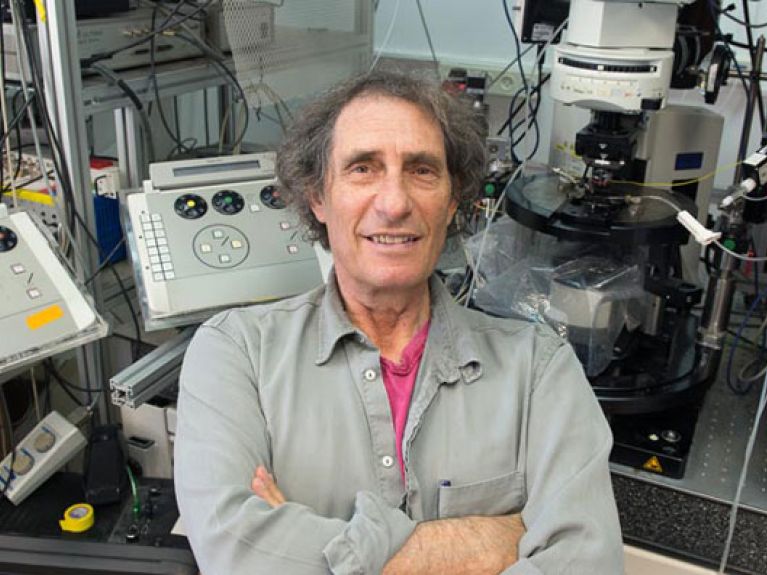What happens in our minds on the way from perception to action? And what changes physically, anatomically in our brain when we learn something new? Three German scientists from the Max Planck Society in Munich and three Israeli researchers from the Hebrew University of Jerusalem together aim to get a little closer to the answer to this puzzle. “We are the theorists, the Germans the experimentalists,” says Idan Segev from the Edmond and Lily Safra Center for Brain Sciences (ELSC). The wiry man in his mid-60s with a head of grey curls is sitting in trainers and green jeans in front of a computer and pointing at the object of his passion: the brain. Anyone who listens to him for longer than five minutes is convinced that there is no more important science than researching our grey matter.
Segev’s enthusiasm is contagious, surely also one of the reasons why he is invited to speak at the colloquium in Rehovot on 11 February, organised by the Israeli Weizmann Institute and German Minerva Stiftung, a subsidiary of the Max Planck Society. It is to mark the anniversary of diplomatic relations between Israel and Germany. The importance of scientific cooperation for these relations is evidenced by the participation of German Education Minister Johanna Wanka at the reception of the two organisations the day before the colloquium.
The German-Israeli sextet headed by Idan Segev is working in three pairs. The project Max Planck Hebrew University Center for Sensory Processing of the Brain in Action is scheduled to run for five years altogether. It was launched in January 2013. Segev’s counterpart in Munich is Alexander Borst, their joint object of study the fruit fly and in particular information processing in the fly’s visual system. The eye of the fruit fly has a relatively small number of neurons, which can be genetically modified and then observed in action. “Borst is an international expert,” says Segev in praise of the collaboration. “He conducts experiments and examines how the light falls on the fly’s eye and the phases it works through until the wings start beating,” explains Segev. “I use the experiments to build a computer model, a mathematical simulation of the visual system and light processing.”
Scientif cooperation paved the way for diplomatic relations
It is a win-win situation for the scientists on both sides, says Segev, and vice versa too Munich-based neurobiologist Tobias Bonhoeffer is very impressed with the joint project. “It would be fair to say that the Hebrew University has the best theoretical neuroscientists in the world.” Bonhoeffer is working on mice together with Adi Mizrahi. The Israeli observes the changed behaviour of mothers after having a litter, while Bonhoeffer investigates the anatomical change in the brain. “The Israeli centre focusses on how a brain functions when it has to perform actions and does not just passively observe,” he explains. Using modern microscopes, the researchers are able to observe the brain of the living mouse. Idan Segev proudly shows the machine that takes up almost an entire room.
The neuroscientists’ project, supported with 300,000 euros annually from both the Hebrew University and the Max Planck Society, is just one of 165 German-Israeli cooperations in the field of science and research. And new ones are emerging all the time. 6.5 million euros of funds from the German Federal Ministry of Education and Research alone go to projects and scholarships annually. Scientific cooperation between Germany and Israel was one of the factors that paved a way for diplomatic relations. As early as 1964 the Minerva Stiftung, which played a leading role in the convergence, formalised cooperation between the Max Planck Society and the Weizmann Institute in Rehovot with a contract. Three years later the first Israeli scientists travelled to Germany on the invitation of Max Planck Institutes.
Creative chaos predominately marks the Jerusalem premises of the neuroscientists. An open packet of biscuits and empty water bottles are lying around, the students and research assistants are sitting in front of a microscope or computer deep in concentration. Only the desk of a postdoctoral fellow from China is impeccably tidy, and microscopic images of the dyed brain of a mouse are hanging on the walls around her. The young researcher is to travel between Munich and Jerusalem in the coming months in order to create an “interactive bridge”, as Segev puts it, between the two institutes. The entire project group (in addition to the six professors also around 15 research assistants) communicates via video link and meets up at a conference once a year, held alternately in Germany and Israel. Moreover, Segev and Borst communicate via email almost daily. The research collaboration has long since given rise to friendships, says the Israeli. “It is much more than just joint work and intellectual exchange.”
